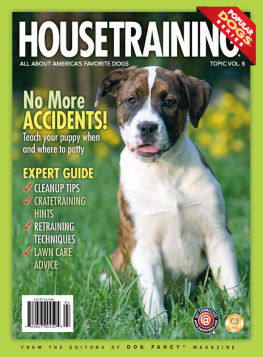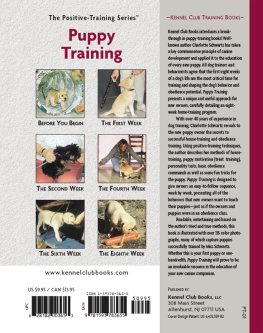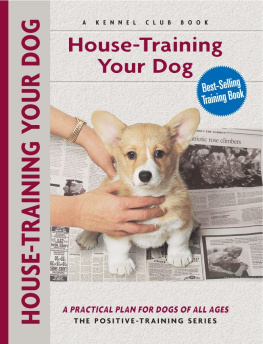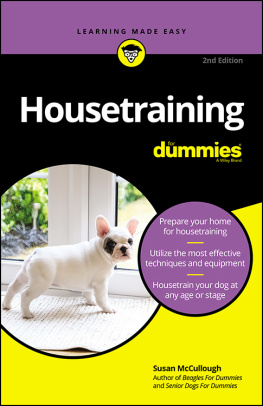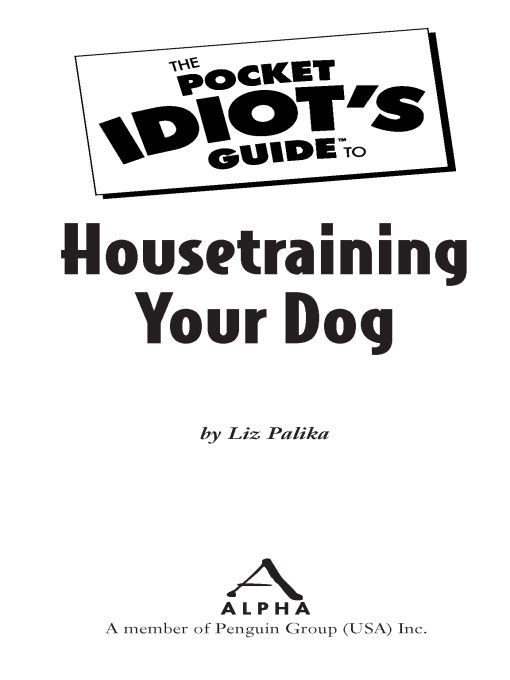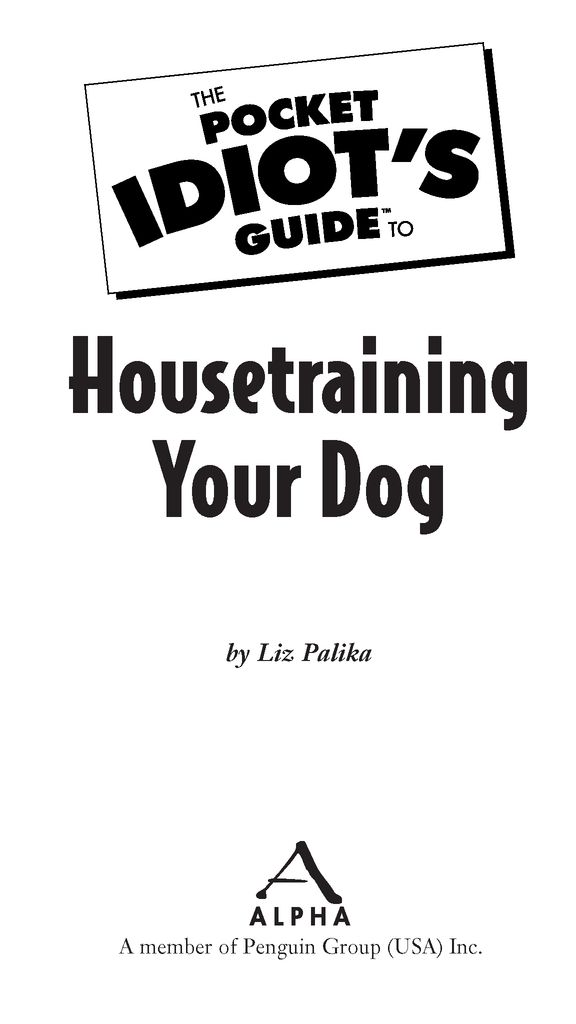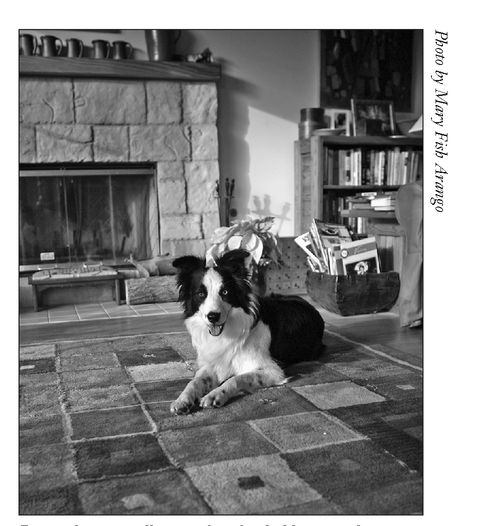Table of Contents
To Bashir, an awesome dog, my heart dog and the
easiest dog I have ever housetrained!
Introduction
I have been teaching dog owners how to train (and live with) their dogs for more than 25 years. This is not just a profession for me; its also a calling. My dogs are a part of who I am, a part of my family. When I can help people understand their dog better and teach their dog some manners, well, then that dog has a much better chance of living out his life with that family. Far too many dogs end up in shelters and rescues because they havent been taught what are acceptable behaviors and what are not.
Problems with housetraining issues are not uncommon. Perhaps the new puppy doesnt understand what is being asked of her, or a newly adopted adult dog is lifting his leg on the dining room table leg. Or worse yet, a once-well-housetrained dog suddenly begins having accidents. Housetraining problems can drive a dog owner to distraction!
It doesnt help the dog owner when every dog trainer, and every dog training book, offers a different solution to the problem. If you listen to or read too many instructions, you and your dog both will be horribly confused. However, in this book I will create order from the chaos. Ill walk you through the process step by step and help you set your dog up to succeed. (My mantra: Set your dog up to succeed!)
My dogs are therapy dogs and visit nursing homes and daycare centers. They must be well housetrained. In addition, my husband and I often travel with our dogs, staying in hotels and motels where accidents are unacceptable. My dogs were all housetrained using the same techniques Im going to teach you. So continue reading!
Extra Help
Throughout the book there are three different types of sidebars. These offer tidbits of extra help to go along with the material in the text. Decoding them is easy.
All the Scoop
These boxes offer helpful hints about the housetraining process. You can find information about the time required to build a habit to the age a puppy can begin learning housetraining skills, and much more. These hints will help make your housetraining efforts more successful.
Lets Get Physical
There are a number of physical challenges your puppy or dog could face that will affect his housetraining skills. Toy breed puppies, for example, often need to eat several small meals throughout the day to offset potential hypoglycemia; this can upset a housetraining schedule unless those meals are taken into account when creating the schedule.
Step Carefully
Housetraining is not always a smooth process; you may well hit some rough spots along the way. If you have adopted an older puppy or adult dog with some housetraining issues, the process can be tough. But very, very few dogs are untrainable. These boxes contain information that can help you through those tough times.
Acknowledgments
Thanks to Mary Fish Arango for her wonderful photographs. Mary, you went above and beyond! Thanks!
Trademarks
All terms mentioned in this book that are known to be or are suspected of being trademarks or service marks have been appropriately capitalized. Alpha Books and Penguin Group (USA) Inc. cannot attest to the accuracy of this information. Use of a term in this book should not be regarded as affecting the validity of any trademark or service mark.
Chapter 1
A Reliably Housetrained Dog Is a Joy
In This ChapterUnderstanding housetraining
What instinct has to do with it
Learning when puppies have to go
Setting some realistic housetraining goals
Theres nothing more frustrating than climbing out of a warm, comfortable bed and stepping into something damp and disgusting. It gets your day off to a bad start and makes you wonder why you ever agreed to get a dog. Unfortunately, when dogs are not reliably housetrained, their ultimate future is in jeopardy; many will be kicked out of the house and live as backyard dogs while others will be relinquished to the local animal shelter. Very few shelter dogs who are not housetrained are adopted.
Although it often seems to be, housetraining is not a mysterious process known only to dog trainers. Housetraining can and should be an easy training regime built on the dogs natural instincts to keep his bed clean. My youngest dog, Bashir, who is now just 2 years old, went through his entire housetraining process without any accidents in the house at all. No puddles and no piles. Now, I think Bashir is a pretty awesome dog, and I will admit Im biased. However, your dog can do the same as Bashir; its not that hard.
Learning All About Housetraining
As a dog trainer, I talk to dog owners every day who are having trouble housetraining their dogs. Often these owners are confused about what, when, and how to housetrain their dogs, and sometimes even about what they want their dogs to do.
Unfortunately, if you dont have a clear understanding of what housetraining is and what your goals are for your dog, you will have a difficult time communicating anything to your dog. And when you and your dog are both confused, well, accidents will continue to happen and frustration and disappointment will build.
My definition of housetraining is simple: it is the process of teaching your puppy or dog to relieve herself when you ask her to do so. Normally she will be asked to do this in a specific spot, but the process also includes learning to relieve herself in different places so that she doesnt have a problem if youre visiting away from home. Housetraining also includes helping the puppy or dog develop bowel and bladder control so she can hold it until its time for her to go.
Dogs who are well trained and reliable are welcome anywhere.
All the Scoop
A dog should never be considered housetrained as long as hes having accidents. There is no such thing as partially or almost housetrained. With housetraining, its all or nothing.
A dog who is reliably housetrained is a joy. He is welcome in his own home as well as in the homes of friends and family. He can do therapy dog work in hospitals and schools without worry about an accident. He can travel with you, staying in hotels or friends homes. On the other hand, the dog who is not housetrained will be left outside, will live his life unwelcome in other places, and could potentially even end up in the local shelter. But before we get into the specifics of how to housetrain your dog, lets take a look at some of the variables that can potentially affect how the process works.



